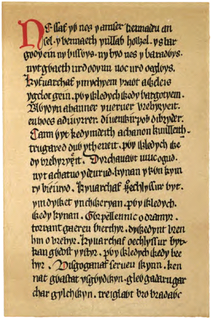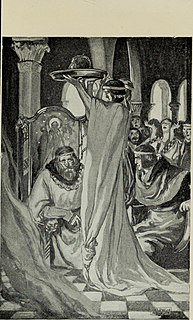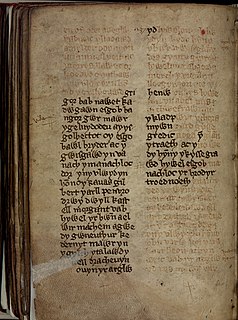Related Research Articles
Taliesin was an early Brittonic poet of Sub-Roman Britain whose work has possibly survived in a Middle Welsh manuscript, the Book of Taliesin. Taliesin was a renowned bard who is believed to have sung at the courts of at least three kings.

The Red Book of Hergest is a large vellum manuscript written shortly after 1382, which ranks as one of the most important medieval manuscripts written in the Welsh language. It preserves a collection of Welsh prose and poetry, notably the tales of the Mabinogion and Gogynfeirdd poetry. The manuscript derives its name from the colour of its leather binding and from its association with Hergest Court between the late 15th and early 17th century.
Peredur is the name of a number of men from the boundaries of history and legend in sub-Roman Britain. The Peredur who is most familiar to a modern audience is the character who made his entrance as a knight in the Arthurian world of Middle Welsh prose literature.

The Welsh Triads are a group of related texts in medieval manuscripts which preserve fragments of Welsh folklore, mythology and traditional history in groups of three. The triad is a rhetorical form whereby objects are grouped together in threes, with a heading indicating the point of likeness; for example, "Three things not easily restrained, the flow of a torrent, the flight of an arrow, and the tongue of a fool."

The White Book of Rhydderch is one of the most notable and celebrated surviving manuscripts in Welsh. Mostly written in southwest Wales in the middle of the 14th century it is the earliest collection of Welsh prose texts, though it also contains some examples of early Welsh poetry. It is now part of the collection of the National Library of Wales, having been preserved in the library at Hengwrt, near Dolgellau, Gwynedd, of the 17th century antiquary Robert Vaughan, who inherited it from the calligrapher John Jones and passed it to his descendants. The collection later passed to the newly established National Library of Wales as the Peniarth or Hengwrt-Peniarth Manuscripts.

The Black Book of Carmarthen is thought to be the earliest surviving manuscript written solely in Welsh. The book dates from the mid-13th century; its name comes from its association with the Priory of St. John the Evangelist and Teulyddog at Carmarthen, and is referred to as black due to the colour of its binding. It is currently part of the collection of the National Library of Wales, where it is catalogued as NLW Peniarth MS 1.

The Book of Taliesin is one of the most famous of Middle Welsh manuscripts, dating from the first half of the 14th century though many of the fifty-six poems it preserves are taken to originate in the 10th century or before.
Medieval Welsh literature is the literature written in the Welsh language during the Middle Ages. This includes material starting from the 5th century AD, when Welsh was in the process of becoming distinct from Common Brittonic, and continuing to the works of the 16th century.
Middle Welsh is the label attached to the Welsh language of the 12th to 15th centuries, of which much more remains than for any earlier period. This form of Welsh developed directly from Old Welsh. The name of the language in Middle Welsh was Cymraec Canawl which had alternate spellings using ⟨k⟩ for ⟨c⟩.

Peredur son of Efrawg is one of the Three Welsh Romances associated with the Mabinogion. It tells a story roughly analogous to Chrétien de Troyes' unfinished romance Perceval, the Story of the Grail, but it contains many striking differences from that work, most notably the absence of the French poem's central object, the grail.
Gwallog ap Lleenog was a hero of the Hen Ogledd. He has long been considered a probable sixth-century king of the sub-Roman state of Elmet in the Leeds area of modern Yorkshire, though some more recent scholarship would identify him more tentatively simply as a 'king of an unidentified region in the north'.
The Legend of the Rood is a complex of medieval tales loosely derived from the Old Testament.

The Ordinalia are three medieval mystery plays dating to the late fourteenth century, written primarily in Middle Cornish, with stage directions in Latin. The three plays are Origo Mundi, Passio Christi and Resurrexio Domini. The metres of these plays are various arrangements of seven- and four-syllabled lines. Ordinalia means "prompt" or "service book".
Brenhinoedd y Saeson is the medieval title of three Middle Welsh annalistic chronicles known from three 14th-century manuscripts recording events from 682 to the English conquest of Wales in 1282. The title Brenhinoedd y Saeson is found only in the rubric to the earlier of the two surviving manuscripts of version S: the other two texts are commonly known as Brut y Tywysogion, but this title is found only in manuscripts of the late 16th century and cannot be considered authentic.
Brynley Francis Roberts, known as Bryn Roberts, is a Welsh scholar and critic, who has written much on the Welsh language and Celtic history. He was Professor of Welsh Language and Literature at the University of Wales, Swansea 1978–1985 and Librarian of the National Library of Wales in 1985–1994, then made editor of the Dictionary of Welsh Biography in 1987 and of Y Traethodydd in 1999. He is on the council of the Honourable Society of Cymmrodorion and involved in the Morfa Chapel, Aberystwyth, part of the Presbyterian Church of Wales.
Brut y Brenhinedd is a collection of variant Middle Welsh versions of Geoffrey of Monmouth's Latin Historia Regum Britanniae. About 60 versions survive, with the earliest dating to the mid-13th century. Adaptations of Geoffrey's Historia were extremely popular throughout Western Europe during the Middle Ages, but the Brut proved especially influential in medieval Wales, where it was largely regarded as an accurate account of the early history of the Celtic Britons.
The Englynion y Beddau is a Middle Welsh verse catalogue listing the resting places (beddau) of legendary heroes. It consists of a series of englynion, or short stanzas in quantitative meter, and survives in a number of manuscripts. The collection is thought to be considerably older than its earliest manuscript, the 13th-century Black Book of Carmarthen, and provides an important early glimpse at medieval Welsh heroic tradition and topographical folklore.

Peniarth 20 is an early Welsh manuscript, written on parchment, that is part of the Peniarth collection in the National Library of Wales. It is also known as the Chronicle of the Princes because it contains an important version of the chronicle Brut y Tywysogion. Daniel Huws, the leading authority on Welsh manuscripts, has argued that the majority of Peniarth 20 dates from circa 1330. A date around the 15th century had previously been offered by J. Gwenogvryn Evans.
Thomas Wiliems was a Welsh-language antiquarian.
"The Poet and the Grey Friar" is a satirical poem in the form of a traethodl by the 14th-century Welsh poet Dafydd ap Gwilym, widely seen as the greatest of the Welsh-language poets. In it he relates an imaginary conversation with a Franciscan friar in which, rejecting the ascetic philosophy of the friar, he sets out a defence of love, poetry and the worldly life. It was included in The Oxford Book of Welsh Verse and The Penguin Book of Welsh Verse.
References
- ↑ J.E. Caerwyn Williams, 'Rhyddiaith Grefyddol Cymraeg Canol', in Geraint Bowen (ed.), Y Traddodiad Rhyddiaith yn yr Oesau Canol (Llandysul, 1974), p. 362.
- ↑ J.E. Caerwynn Williams, "Medieval Welsh Religious Prose," p. 79.
- ↑ Trioedd Ynys Prydein: the Welsh Triads, ed. Rachel Bromwich, 2nd ed. (Cardiff, 1978), 35.
- ↑ J.E. Caerwynn Williams, Medieval Welsh Religious Prose, p. 81.
Editions and translations
- Jenkins, John (ed.). "Medieval Welsh Scriptures, Religious Legends, and Midrash." Transactions of the Honourable Society of Cymmrodorion (1919–20), pp. 121–131. Edition based on Peniarth 5 with variants from Peniarth 14 and Hafod 22.
- Jones, Thomas Gwynn (ed.) and G. Hartwell Jones (tr.). Ystorya Addaf' a 'Ual a Cauas Elen y Grog': Tarddiad, Cynnwys, ac Arddull y Testunau Cymraeg a'y Lledaeniad [dissertation]. TYCCh 847.
- Williams, Robert (ed.). Selections from the Hengwrt Manuscripts, vol. 2 (London, 1892), 243-50. Based on Peniarth 5. Available from the Internet Archive
General studies
- Williams, J. E. Caerwyn, "Medieval Welsh Religious Prose," Proceedings of the Second International Congress of Celtic Studies, 1963 (Cardiff, 1966), 65-97.
- For the source, see main entry Legend of the Rood .